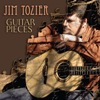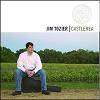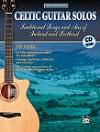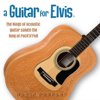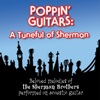| FAQ |
| Composing/Arranging |
A: I was a songwriter for many years while playing in bands (was always a better songwriter than guitarist, in fact) and much of my approach to writing instrumentals is the same. I still think in terms of verses, choruses, and bridges... so my song structures are somewhat predictable and familiar. I think that helps make my tunes accessible, especially to listeners who might not typically listen to instrumental guitar music. As far as writing the actual tunes, they always start with a melody... and the melody has to be something I can hum, because I usually don't record song ideas or write them down. So I have to be able to remember them, and I'll often come up with additional parts to the song while I'm not playing guitar. The original melody will just bounce around in my head while I'm driving or doing chores around the house, and I'll get an idea for where to go next. Then I have to keep humming it until I can get to a guitar and figure out how to play it. The combination of humming and physically playing the notes on the guitar tend to be enough to keep it in my memory. Q: How do you know when a song is finished?
A: Because I write and structure my instrumental songs much like I did when writing songs with lyrics, they tend to follow patterns in terms of where the verses, choruses and bridges fall, and tend to resolve the same way. The main difference is that with instrumental tunes, I usually keep the songs a little shorter, since the lyrical element isn't there to help maintain the listener's interest as long. Q: What's your approach for arranging?
A: Very similar to writing... I start with the melody and build everything else around that. Of course, when arranging tunes the melody is already there to work with, so it's simply a matter of deciding how to adapt it to solo guitar. I usually try to keep the arrangement fairly simple so that the emphasis stays on the melody. After all, the tune is already very good (or I wouldn't be arranging it in the first place), so it really doesn't need any "help" from me by adding fancy guitar playing. Q: How do you choose the songs to arrange?
A: There are two main qualities I look for when choosing tunes to arrange. Obviously, it has to be a song that I really enjoy, and it has to have a great melody. Just as important, it has to be a song that I think I can render effectively on solo guitar. For my style, this usually means that the melody has to stand up pretty well on its own, because other than fleshing out the bass line and chords, I'm probably not going to worry about an intricate arrangement that captures all of the song's original instrumentation. Q: How do you know what tuning to use?
A: I usually want a new song or arrangement to fall into one of the tunings I already use regularly (DADGAD, CGDGAD, and CGCGCD). Obviously, there are people like Pierre Bensusan who can make anything work in DADGAD and El McMeen who can do everything in CGDGAD... but I like to let the tuning do some of the work for me, so I'll pick the familiar tuning which makes the song easiest for me to play. I'll usually start by trying the song in DADGAD, and if I like the way the melody falls beneath my fingers, I'll check to see if the bass notes also work out. Depending on the key, sometimes it's easier to switch to CGDGAD to take advantage of different open bass notes. If the melody isn't working out in one of the xxDGAD tunings, I'll try it in CGCGCD. Or sometimes--especially if I want to take advantage of droning notes, I might try CGCGCD first. It's usually only once I've decided there's something I don't like about the way the song is working in those three tunings that I'll start adjusting other strings to address the "problem" spot. This is why some of my songs have ended up in tunings that are just minor variations of those three: DGDGAD, CGCGCE, CGCGCEb, etc. Q: How do you decide what to play in a duet?
A: It depends on the situation--who I'm playing with (and why), and what song we're doing. On a couple of the duets I recorded with Al Petteway, "The Ride of the Red Knight" and "Dragonflies," I specifically wanted Al to play lead so I wrote in parts for myself that were strictly rhythm. On the Christmas medley we did for the Castlerea CD, I wanted the focus to be on harmonies, so I wrote the melody arrangement and then gave it to Al and let him come up with a harmony part (which he did on the bouzouki). When I wrote "The Water-Crossers," I really hadn't thought about it being a duet, but as I was recording it Al kept hearing a harmony part and asked if he could add it. Of course I said yes, and now I can't imagine the song without it. If I'm playing a duet with someone who already has a melody arrangement worked out, then I'll try to add a harmony part. It's a little more challenging--but also really fun--to come up with a complimentary part that adds something to the original arrangement. When I recorded "O Come, O Come, Emmanuel" with John Sweet, I used an open Cm tuning (CGCGCEb) to create a harmony part, and then we did something unusual by having the song start out with me playing the harmony first and John coming in with the melody later. When Mike Golay asked me to join him for a live duet on his arrangement of "Peggy Gordon," I listened to the recorded version he had done with Al Petteway, and then came up with a harmony part that had a similar feel. During my 2008 summer tour, Celtic guitarist John Sherman and I did a couple of duets when I was in Ohio. We sat down and ran through each tune a few times a couple of hours before we performed them. Two of the songs were completely new to me, so I mostly let John play the melodies while I did a combination of harmonies and chord accompaniment. Finally, I've had the opportunity to do a few live duets with flatpicking champion Allen Shadd. We play "Dragonflies" and a song Allen wrote called "Sister's Waltz." In these situations, the only smart thing to do is stick to the melody and let Allen do his thing!

